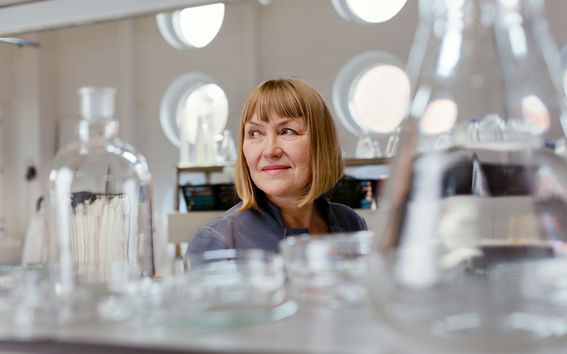'It's time for us to rediscover plants with natural textile fibres'

Each year, on the evening of 6 December, all eyes in Finland are glued to the television to watch the nation's annual Independence Day ball. The event is a national institution, viewed as much for patriotic reasons as to see the designer dresses worn by the female guests. At last year's ball, it was the dress of the hostess herself – Jenni Haukio, spouse of the country's president – that created headlines not just in Finland, but right around the world.
The material for the dress Mrs Jenni Haukio wore had been made entirely from Finnish birch-tree cellulose through an environmentally-friendly technology called Ioncell. Part of Aalto's R&D portfolio since 2010, the Ioncell process uses ionic liquids developed with the University of Helsinki as solvents to dissolve wood pulp, old textiles, and even newspapers to produce high-quality textile fibres. Ioncell is viewed as a promising alternative in an industry now urgently seeking more sustainable textiles, and has already drawn international interest from the likes of Nike, Adidas, H&M, Zara and IKEA.
Technology for new textiles
Much of the work on Ioncell is done by a cross-faculty team of engineers, chemists, and designers led by Professor Herbert Sixta at the Aalto School of Chemical Engineering. Pirjo Kääriäinen, Professor of Practise for Aalto University's CHEMARTS project has been facilitating this collaboration on behalf of the university's textile and fashion design practises. Before joining Aalto in 2008, Kääriäinen spent some 20 years working in the textile industry.
'The global problem in this industry is that two thirds of the approximately 105 billion tons of fibre used each year to create textile are fossil based, and one quarter is cotton, which consumes a lot of water and pesticides,' she says. 'Currently, only six percent of global textiles are based on man-made cellulosic fibres like lyocell or viscose, and the amount of natural fibres like wool or linen is a little over five percent.
'But we're now seeing more and more technologies being developed that create textile fibre based on cellulose, or on waste products,' she says. 'Ioncell is a particularly interesting technology because it can be used to create extremely good textile fibres from so many different raw materials, including cotton or cardboard waste.
Pirjo KääriäinenIoncell can be used to create extremely good textile fibres from so many different raw materials, including cotton or cardboard waste."
Turning back to nature
Finland's pulp and paper industry, long a mainstay of the national economy, has seen demand for some of its traditional products slump in recent years. At the same time, there has been steady growth in demand for more sustainable raw materials in the textile industry. This led to a series of funding instruments and shared research projects being established in Finland, so that the pulp and paper industry could explore the creation of cellulose-based raw materials for textile customers.
'Today, there are seven different projects happening in Finland related to cellulose-based textile fibre, one of which is Ioncell,' says Kääriäinen. 'I have very high hopes that some of these projects will make it out into the world at scale and help us to start solving the problems created by the global textile industry.'
While cellulose from wood-pulp production is the natural place for the industry to start in Finland, there are fibres in many other types of plants that offer hope for a more natural solution to the textile challenge.
'It's time for us to rediscover plants with natural textile fibres, such as hemp, flax and even nettles. But we need to ensure safe and sustainable methods to cultivate and process these plants,' says Kääriäinen. 'A hundred years ago, when flax was still widely cultivated in Finland, many small lakes here were polluted by flax processing. We wouldn't want to re-create that kind of problem.'
Sustainability at every stage
While she is positive on developments in raw materials, Kääriäinen cautions that this is only one part of the sustainability puzzle.
Beyond the creation of the material itself, there are many more steps in the value chain for textile products where sustainability needs to be enhanced. For example, a button-up shirt is typically made in over 20 different production stages, with waste or pollution at each stage. In the fabric cutting room, off-cuts that don't fit into a given style pattern are often simply discarded. Further down the chain, dyeing and finishing processes often use a lot of water and release toxic chemicals into the environment.
'Introducing more sustainable raw material is important, but it's only one part of the broader sustainability picture,' says Kääriäinen. 'We also need to start using materials for far longer than we do, and to recycle every single piece.'
'We need to get rid of the chemicals in this industry,' she says. 'This is why Ioncell is so interesting, as it uses no other chemicals than ionic liquids, which are basically salts.'
'Dyeing is a chemical-heavy process, but there are early bio-technologies opening up more sustainable ways to do this too, including the use of bacteria as dyes. It's early days yet, but there is a lot of research happening in this area.'
Pirjo KääriäinenWe need to disrupt the whole fast fashion system. There is no choice in the longer run – we simply cannot go on like this."
Disrupting fast fashion
Kääriäinen says that the final piece in the puzzle is for change to take place in the fashion-industry's attitude towards demand creation, take-back and recycling.
'We need to disrupt the whole fast fashion system", she says. "There is no choice in the longer run – we simply cannot go on like this. The big picture in the future is to make high quality garments that we can use for 10 years, rather than just 10 days!'
Kääriäinen says that for this vision to become reality, fashion-industry business models need to become more flexible about raw material inputs.
'With Ioncell, for example, the colours of some raw materials can actually remain throughout the process, which would make finishing more sustainable by reducing or eliminating the need for dye,' she says. 'But of course it may not always be possible to create a thousand meters of material of exactly the same colour, as the fashion industry is used to with cotton and fossil-based wovens. So systems need to change as we introduce these new technologies.'
'Luckily the global community has now woken up to the magnitude of the problem, and we have so many potential solutions under development,' she says. 'With changes at the individual, corporate and government level, I still have hope that we can successfully address this issue before it's too late.'
***
Finland will present its exhibition Everyday Experiments at the XXII Triennale di Milano from 1 March to 1 September this year, featuring twelve experimental projects people are already doing to make their lives more sustainable and equitable. The Finnish exhibition is organized and designed by Aalto University teachers and students, from the exhibition design (Monica Romagnoli, Saara Kantele, Ville Kokkonen and Tuomas Siitonen) to curation (Kaisu Savola and Guy Julier) to graphic identity (Adina Renner and Qin Yang).
La Triennale di Milano 2019 is curated by Paola Antonelli, Senior Curator of Architecture and Design and Director of Research & Development at The Museum of Modern Art. Broken Nature will reflect on the relationship between humans and environments at all scales—from the microbiome to the cosmos—including social, cultural, and natural ecosystems.
Read more:
Everyday Experiments: everdayexperiments.aalto.fi
The XXII Triennale, Broken Nature
Video on Ioncell: This dress is made out of birch
Read more news

Sebastian Szyller: I want to make machine learning more dependable and resilient to attacks
Sebastian Szyller has been appointed assistant professor at Aalto University Department of Computer Science as from 1 September 2025. He studies how to train privacy-preserving machine learning models, how to safeguard them and ensure robust predictions in untrusted environments
The pilot project for direct article delivery from the National Repository Library ends
Aalto University has been participated in the pilot project for direct article delivery with the National Repository Library and Kopiosto from 2023 to 2025. The pilot ends on 19th December.
Aalto students and researchers shape together how we age with AI at Junction hackathon 2025
The 'Aging with AI' hackathon challenge sparked a winning solution connecting generations over shared learning experiences, preserving cultural skills.






